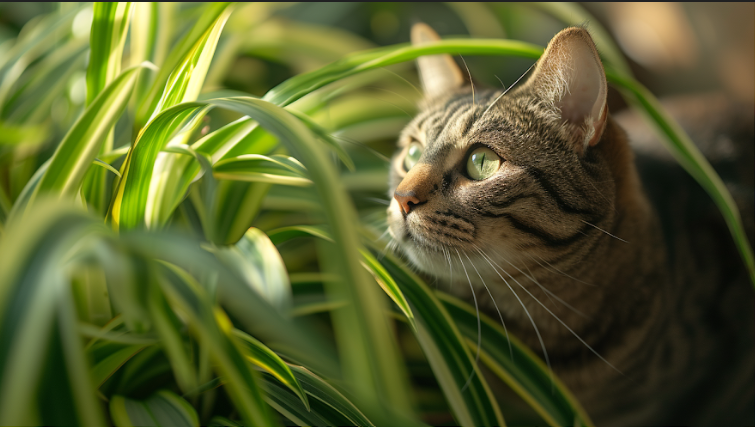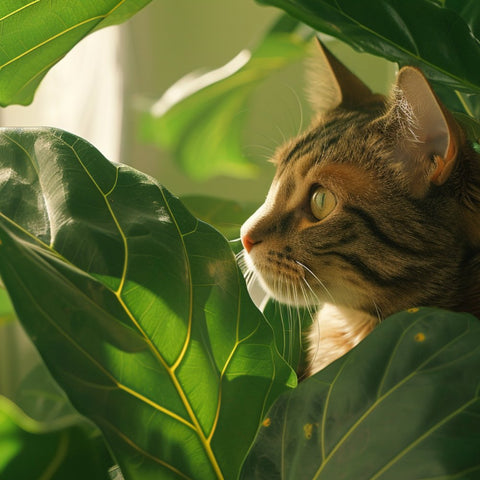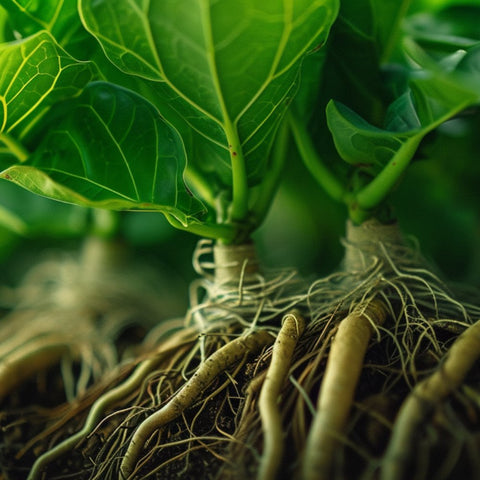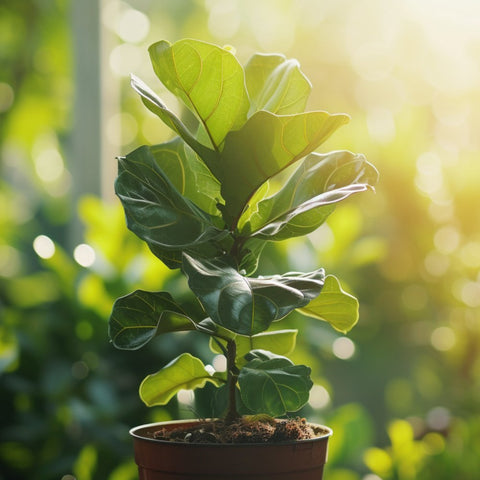Blog Post - Fiddle Leaf Figs Toxic to Cats: A Guide to Pet Safety Around Houseplants
Introduction:
Houseplants can bring life and beauty to any space, but it's important to consider the safety of our beloved pets when choosing indoor greenery. In this article, we will focus on fiddle leaf figs and their potential toxicity to cats. Join us as we delve into the characteristics of fiddle leaf fig plants, discuss the hazards they pose to cats, and provide measures to keep our furry friends safe.
I. Fiddle Leaf Fig Plant: A Houseplant Favorite

Fiddle leaf fig plants, scientifically known as Ficus lyrata, are native to tropical rainforests and have gained immense popularity as houseplants in recent years. With their large, glossy leaves that resemble the shape of a violin or fiddle, these plants add a touch of elegance and sophistication to any home. They thrive in bright, indirect light conditions and can grow up to six feet tall indoors, making them a stunning focal point for any room.
II. Hazards of Fiddle Leaf Figs to Cats

While fiddle leaf fig plants may be a visual delight, their beauty comes with a hidden danger for our feline companions. These plants contain harmful compounds that can cause significant health issues if ingested or if a cat comes into contact with their sap.
A. Toxicity of Fiddle Leaf Figs to Cats

Fiddle leaf fig plants are considered toxic to cats. The leaves, stems, and sap of the plant contain compounds such as ficin and psoralen, which can be poisonous to cats when ingested or when they come into contact with their skin. These compounds can cause mild to severe symptoms, depending on the amount ingested and the cat's individual sensitivity.
B. Potential Dangers of Ingestion or Contact
Cats are naturally curious creatures, often exploring their environment by sniffing and nibbling at objects around them. When it comes to fiddle leaf fig plants, ingestion or contact with the plant can lead to a variety of health problems. These may include vomiting, diarrhea, excessive drooling, mouth ulcers, difficulty breathing, and even kidney or liver damage in severe cases.
III. Symptoms and Risks for Cats
It's important for cat owners to be able to recognize the symptoms of fiddle leaf fig toxicity in their pets and understand the potential risks involved.
A. Typical Symptoms Seen in Cats After Exposure
If a cat has ingested or come into contact with a fiddle leaf fig plant, common symptoms to watch out for include gastrointestinal upset (vomiting, diarrhea), oral irritation (drooling, pawing at the mouth), skin irritation or rashes, breathing difficulties, excessive lethargy, and changes in appetite or behavior.
B. Potential Health Risks Associated with Ingestion
While mild cases of fiddle leaf fig toxicity may result in temporary discomfort for cats, severe cases can have more serious consequences. Ingestion of larger amounts of the toxic compounds found in fiddle leaf figs can lead to organ damage, especially to the kidneys and liver. Prompt veterinary attention is crucial to ensure a cat's swift recovery and prevent long-term complications.
IV. Preventive Measures: Keeping Cats Safe
Protecting our cats from the dangers of fiddle leaf fig plants starts with prevention. Here are some practical steps you can take to safeguard your furry friends:
A. Keep Cats Away from Fiddle Leaf Fig Plants
To discourage cats from accessing fiddle leaf fig plants, try placing them in areas that are inaccessible to your pet, such as high shelves or hanging baskets. You can also use physical barriers like baby gates or plant stands with protective grids to prevent direct contact. Additionally, providing your cat with alternative sources of stimulation, such as scratching posts and interactive toys, can help redirect their attention away from the plants.
B. Pet-Friendly Houseplant Alternatives

If you're a devoted fiddle leaf fig enthusiast but concerned about your cat's safety, there are plenty of pet-friendly houseplant alternatives to consider. Spider plants, Boston ferns, and Christmas cacti are just a few examples of plants that can bring beauty to your home without posing a risk to your feline companions. Always research the toxicity of any plant before introducing it to your living space.
C. Training Cats to Avoid Houseplants
Training your cat to avoid houseplants is another effective way to ensure their safety. Using positive reinforcement techniques, reward your cat with treats or praise when they show disinterest in the plants and redirect their attention to appropriate toys or activities. Consistency and patience are key when teaching your furry friend the house rules.
V. Steps to Take if Cat Ingests Fiddle Leaf Fig
Accidents happen, and despite our best efforts, cats may still manage to ingest parts of a fiddle leaf fig plant. If you suspect your cat has come into contact with or consumed any part of the plant, here are the immediate steps to take:
A. Immediate Actions to Take in Case of Ingestion
- Remove the cat from the plant: Safely remove your cat from any further contact with the fiddle leaf fig plant.
- Check for visible symptoms: Assess your cat for any immediate signs of distress, such as difficulty breathing or excessive drooling.
- Call your veterinarian: Contact your veterinarian or an emergency pet clinic as soon as possible for guidance on the next steps to take.
B. Importance of Contacting a Veterinarian
Though the severity of the cat's symptoms may vary, it is crucial to seek professional veterinary advice if your cat has ingested or come into contact with a fiddle leaf fig plant. The veterinarian will be able to provide accurate assessment and guidance based on your cat's individual circumstances and may recommend further steps such as inducing vomiting or supportive care.
C. Additional Measures to Support Your Cat's Recovery
Depending on the level of toxicity and symptoms exhibited, your veterinarian may recommend additional measures to support your cat's recovery. This may include administering activated charcoal to absorb any remaining toxins, intravenous fluids to flush out the system, or medication to alleviate discomfort and promote healing.
VI. Conclusion: Responsible Pet Ownership

In conclusion, while fiddle leaf fig plants can be a stunning addition to our homes, it's important to prioritize the safety of our furry friends. By being aware of the potential hazards and taking preventative measures, we can create a harmonious living environment for both our cats and our beloved houseplants.
Remember, responsible pet ownership means staying informed about the potential dangers that certain plants can pose to our pets. Always research the toxicity of any new houseplants before bringing them home, and never hesitate to reach out to a veterinarian for guidance if you suspect your cat has been exposed to a toxic substance.
Let's ensure the well-being of our cats and foster a safe and loving environment for them to thrive alongside our green companions. Together, we can create a pet-friendly home where everyone can enjoy the beauty of nature without compromising on safety.






























Comments (0)
There are no comments for this article. Be the first one to leave a message!